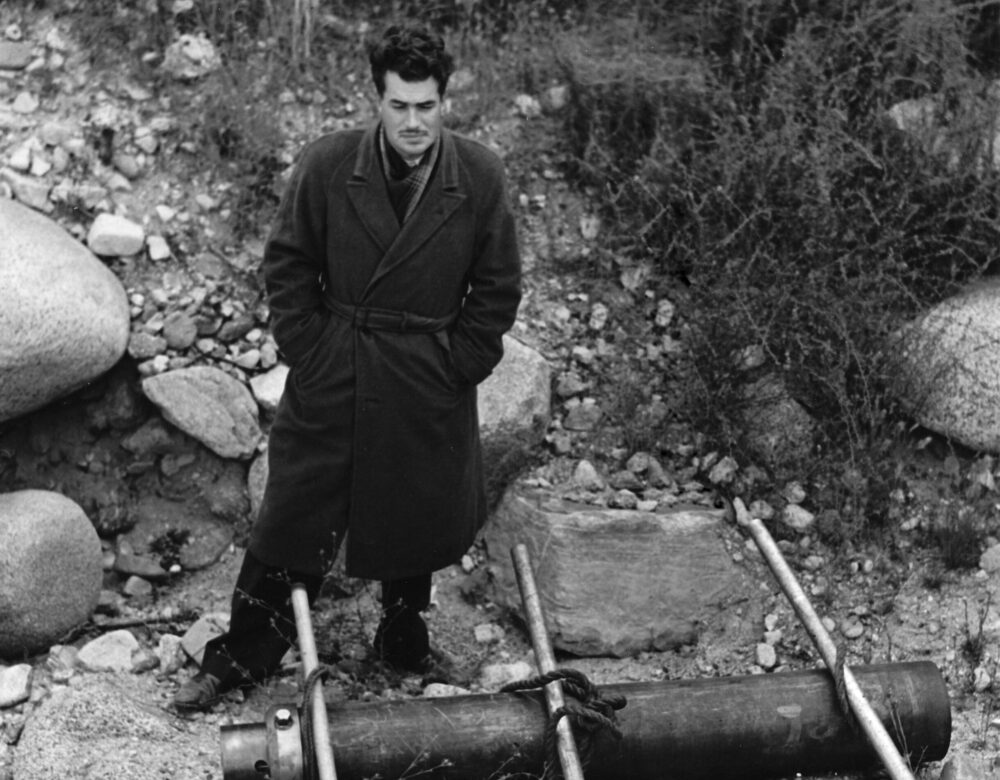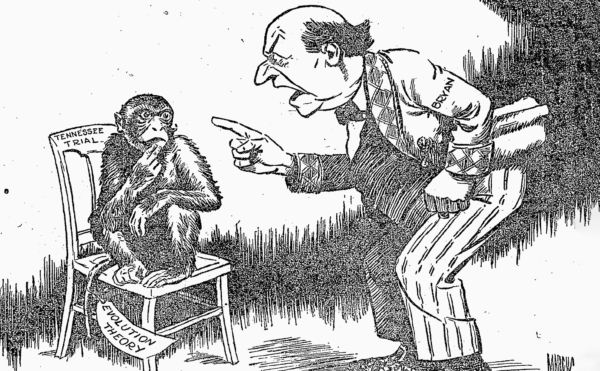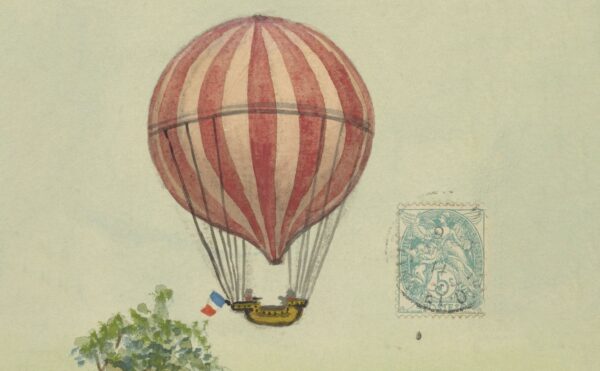Jack Parsons was a brilliant rocket scientist, but he lived a wild lifestyle. With a devil-may-care attitude, he was pretty relaxed about safety and dabbled in drugs, occult practices, and sex-cult rituals. It would all eventually catch up to him though. Continue with Part 2 of this two-part series.
About The Disappearing Spoon
Hosted by New York Times best-selling author Sam Kean, The Disappearing Spoon tells little-known stories from our scientific past—from the shocking way the smallpox vaccine was transported around the world to why we don’t have a birth control pill for men. These topsy-turvy science tales, some of which have never made it into history books, are surprisingly powerful and insightful.
Credits
Host: Sam Kean
Senior Producer: Mariel Carr
Producer: Rigoberto Hernandez
Associate Producer: Sarah Kaplan
Audio Engineering: Rowhome Productions
Transcript
In 1938, the U.S. army approached scientists at MIT with an offer. The army had a pot of money to fund two research projects, and MIT would get first choice. Which project did they want?
The first choice involved deicing airplanes. Planes often fly through clouds in cold and wet conditions. So what’s the best way to keep them ice-free?
The second project involved rocketry. The army wanted to strap rocket engines to planes to boost their speed and shorten takeoff times. And who knows, maybe even send rockets into space one day!
For MIT, it was an easy choice. They picked deicing planes. Why? Because rockets were cheesy science-fiction crap—a Buck Rogers fantasy. No one took rocketry seriously except for foolish dreamers and scruffy pulp fiction writers.
Army officials nodded. They understood. They had figured MIT would never risk its reputation on something as wild as rockets. Still, the army did want to fund some rocket research. They just needed to find someone willing to take the risk.
They eventually found the perfect candidate. A self-taught chemist and rocket obsessive in California.
So why didn’t this fellow care about risking his reputation? Probably because his reputation was already in the dumps, and would soon get worse. He dabbled in the occult. He summoned sex demons. He became bosom buddies with L. Ron Hubbard of Scientology fame.
And yet, Jack Parsons proved one of the most brilliant rocket scientists in history, despite his kooky ideas—or perhaps, even because of them.
Jack Parsons was born in Pasadena, California, in October 1914. Shortly afterward, his father got caught sleeping with another woman, and even paying her for sex. His wife left him, and she and Jack moved in with her wealthy parents. They lived on a grand estate on so-called Millionaires’ Row in Pasadena.
Jack loved growing up there; he had the run of the whole grounds. As a devoted science-fiction geek, he and a school buddy named Edward Forman started launching amateur rockets there. They’d remove the explosive powder from cherry bombs and other fireworks for fuel.
Now, they mostly just ended up blowing holes in the backyard, but it wasn’t all their fault. To fly, rockets need steady thrust. That requires a fuel that burns steadily. Unfortunately, explosive powders are mixtures of multiple substances. And if you jiggle the powder too much, those substances start to separate into layers. In which case, instead of burning steadily, the powder explodes. Not ideal for rockets.
But little Jack came up with an idea. After thoroughly mixing the powder, he poured glue all over it. The glue hardened, and prevented the powder from separating. He still couldn’t launch the rockets very high, and the backyard still looked like a bombing range. But he was proud of his little innovation with the glue. In fact, he later returned to the idea with spectacular results.
Beyond rocketry, Parsons had darker hobbies, too. Like the occult. At age 12, he tried summoning a demon in his bedroom. For some reason, he was convinced it worked. This scared the crap out of him. He swore off necromancy forever. It was a promise he would not keep.
Between blowing up the backyard and summoning demons, Parsons had a bit of a discipline problem. So in 1929, his mother sent him to a military academy. He promptly blew up a toilet there and got expelled.
But the family soon had much bigger worries than Parsons’s teenage rebellion. In October 1929, the stock market crashed, and his grandfather’s fortune got wiped out.
Things got so dire that the 15-year-old Parsons took a job to help support the family. He chose the Hercules Powder Company. There, he could teach himself more chemistry—and steal explosives.
After high school, he attended college, but dropped out because he couldn’t afford the tuition. From then on, all his chemistry knowledge would be self-taught.
In 1935, Parsons married his high-school sweetheart, Helen Northrup. That same year, his life swerved forever when he attended a lecture on rocket engines at Caltech. He went with Edward Forman, the friend who had helped make cherry-bomb rockets in his backyard.
While socializing after the lecture, Parsons and Forman met some people who eventually introduced them to Frank Malina, a Caltech student writing a Ph.D. thesis on rocketry.
They asked Malina about getting access to Caltech’s resources—money, lab space, its 200-mile-an-hour wind tunnel. They also started babbling about using rockets to visit outer space, and explore other planets.
Now, Malina was a rare credentialed scientist who not only studied rocketry, but loved thinking about space travel. He’d been obsessed with space exploration ever since reading Jules Verne as a child.
But Malina knew that talking openly about space rockets then was about as bad as confessing that you summoned demons. So Malina told Parsons and Forman to zip it. They had to be shrewd. They could talk about adapting rocket engines for planes. But they could never mention space-rockets except in secret.
With that understanding, the trio joined forces. But despite their secrecy, they struggled to find funding. Rockets just seemed too crazy. So, Malina and Parsons began writing a screenplay about two heroic rocket scientists. They hoped to sell the script to a movie studio, and use the cash to support their research.
When that plan fizzled, Parsons began diverting every spare dollar he earned at work toward rocket equipment. He also sold bootleg nitroglycerin that he made at home. He even pawned his wife Helen’s wedding ring for extra cash. You can imagine how she felt about that.
The trio’s first tests took place in the Mojave Desert. Amazingly, rocketry research had barely advanced in the preceding 120 years. The most advanced rockets then were basically the same ones the British used during the War of 1812. You know, the “rockets’ red glare” of the “Star-Spangled Banner.”
The trio in the desert would finally surpass that creaky technology—although not without some hiccups.
As the group’s chemist, Parsons focused on making the rocket fuel. He tried both solid and liquid fuels.
The solid fuel was gunpowder. But again, gunpowder is a mixture of several substances—charcoal, sulfur, and saltpeter. On a molecular scale, these substances are different sizes. And if they’re jostled, those substances separate out.
You’ve seen something similar if you’ve ever opened a can of mixed nuts and noticed all the big Brazilian nuts on top. Jostling the can allows the little nuts to slip down and wedge into small spaces, that forces the big nuts up to the top. This same phenomenon happens with the differently sized molecules in gunpowder. This separation causes gunpowder to explode instead of burn steadily—a problem for rockets.
Parsons also tried liquid-fuel rockets. His liquid-fuel motors had two hoses. One fed in liquid oxygen, the other methyl alcohol. These liquids mixed inside a chamber, where an ignition system sparked them to start the burn.
The first big test with a liquid-fuel motor took place on Halloween in 1936. It did not go well. The motor failed to fire three times. On the fourth, the oxygen hose started on fire, and began spewing flames at them.
But the trio did get better. By January 1937, their liquid engines were producing impressive amounts of thrust. As a result, a faculty member at Caltech offered them some lab space on campus. It was a big break.
During the move, the trio decided to call their new outfit the Jet Propulsion Laboratory—the famous JPL of NASA fame today. By all rights, it should have been called the RPL, for Rocket Propulsion Laboratory. But again, talking about rockets was considered kooky.
Meanwhile, the 23-year-old Parsons was making a name for himself in the newspapers. In 1938, a Los Angeles police captain was arrested for trying to murder a private detective. The detective had dug up some dirt on police corruption. So the captain planted a pipe bomb in his car. It exploded but didn’t kill the detective. The captain was put on trial for attempted murder.
As a local explosives expert, Parsons became the trial’s star witness. He even built a replica pipe bomb and blew up a Chrysler. The press gobbled it up.
It didn’t hurt that Parsons was six-foot-two and handsome, with sweeping jet-black hair and a Clark Gable mustache. His damning testimony sent the crooked police captain to prison, and made Parsons a minor celebrity.
This celebrity, along with several promising rocket tests, helped Parsons and JPL secure several thousand dollars in grants. One grant involved developing rocket-plane engines for the army.
Unfortunately, the JPL trio quickly wore out their welcome at Caltech. Their work was pretty noisy, with engines revving day and night. And Parsons had a, let’s say, relaxed attitude about safety. His equipment suffered chemical leaks all the time. One leak scorched an entire lawn outside. Another seeped into other labs in the building and corroded all the metal equipment there.
Then there were the explosions. One proved especially dangerous. It almost decapitated someone, and left a thick piece of shrapnel embedded in a wall. Overall, JPL spent a quarter of its grant money just repairing buildings around campus. People referred to them as “the suicide squad.”
In 1940, JPL was finally banished from campus. They set up shop instead in a canyon in western Pasadena. It was pretty rugged at first, just some unventilated iron sheds to store equipment.
But their facilities grew and grew, and eventually became what’s now the JPL campus today. Malina and Parsons soon emerged as the driving forces of JPL.
Their relationship was tense sometimes. Melina was methodical. He stressed the need to collect data and understand each step before moving on. Meanwhile, Parsons always wanted to race ahead. Even before one motor was built, he was already babbling about his next big idea.
But to be fair, Parsons had plenty of brilliant ideas. People began joking that JPL really stood for Jack Parsons’s Lab—he was that important.
Before long, however, that joke began to grate on the other members of JPL. They even grew to hate Parsons’s presence there. Why?
Because, even though he’d sworn off summoning demons, Parsons had never quite given up his fascination with the occult. In fact, that obsession was about to take over his life.
Jack Parsons always had a literary side. He read poetry and Greek mythology. He also joined a science-fiction club in Southern California, where he rubbed elbows with Robert Heinlein and Ray Bradbury.
But above all, Parsons read about the occult. He was especially enamored with the British satanist Aleister Crowley—a man who once declared himself to be the so-called Great Beast 666.
Parsons didn’t hide these interests from his colleagues at JPL. To the contrary, during rocket tests, he would recite a poem of Crowley’s called “Hymn to Pan.” He said it brought good luck. His colleagues just laughed and shook their heads. One called him a “delightful screwball.” No one took it seriously.
Except for Parsons, who took it way too seriously. Parsons saw rocketry and the occult as two sides of the same coin. Both offered a chance to slip off the bonds of Earth and roam free. Rocketry freed your body to roam, while the occult freed your mind and soul.
In 1939, Parsons and his wife Helen attended a so-called gnostic mass. It’s a rite in a religion called Thelema. Aleister Crowley invented Thelema in the early 1900s. It drew on a mélange of different practices, from ancient Egypt to pagan rites to Free Masonry.
Two central aspects of Thelema are magick and sex rituals. In Thelema, magick doesn’t mean stage illusions. It’s more like paranormal experiences: interacting with spirits, talking with the dead.
Meanwhile, sex rituals are exactly what they sound like. In Crowley’s religion, sex was considered a sacrament. And during the gnostic mass, worshippers ate so-called Cakes of Light. They’re eucharists made of flour, honey, oil, ash, and often bodily fluids like semen or menstrual blood.
After attending the mass, Parsons and Helen grew fascinated with the religion. Parsons even began trying magick rituals himself. He interpreted his experiences through the new science of quantum mechanics.
With his typical manic enthusiasm, Parsons also began recruiting people to try his new religion. His scientific colleagues all said, uh, no thank you. But Parsons and Helen did recruit Helen’s half-sister, Betty.
Parsons and Helen eventually moved into a mansion with several other Thelemic worshippers. They essentially formed a commune, with each person paying $100 for rent.
To Parsons’s delight, the house sat on Millionaire’s Row—the same street he grew up on. It was a three-story American Craftsman mansion. It had pitched roofs, palm trees, and a wide front lawn. A former Caltech benefactor had built it. Albert Einstein used to stay there when he visited campus.
But now Parsons and his fellow occultists lived there. And Parsons threw himself into the lifestyle. He decorated his and Helen’s room with a statue of the licentious Greek god Pan. He also displayed his collection of swords and daggers.
Now, Millionaire’s Row was also home to several well-heeled society types. Like Lily Busch, heiress to the beer fortune. And these bluebloods did not appreciate their new neighbors, who tended to throw wild parties with loud jazz music. Tsk, tsk.
But whenever the police stopped by to investigate, Jack Parsons would meet them at the door. He would casually mention his job as an esteemed scientist at Caltech. Why, he was practically the incarnation of respectable, middle-class values. Reassured, the police would leave.
Still, things got messy at the commune in 1941. That summer, Parsons’s wife Helen took a long vacation. And while she was gone, the 26-year-old Parsons started sleeping with her half-sister Betty. He did so with the full knowledge and support of his housemates—even though Betty was 17 years old.
When Helen returned, Parsons confessed everything. But he didn’t apologize. In fact, he bluntly told Helen that he found Betty far more provocative. He was determined to be with her. Betty also declared her love for Parsons.
Now, this obviously stung Helen. But instead of wallowing, she simply began an affair with the spiritual leader of the commune, a man named Smith. That affair also blossomed into love. All’s well that ends well, I guess.
All the love-triangle stuff was Parsons’s personal life. It didn’t really affect his work at JPL on rockets. But other club activities did. Commune members drank heavily and used a lot of drugs. This clouded Parsons’s thinking and left him exhausted.
Then one commune member borrowed a gun from Parsons. With it, the man drunkenly hijacked a car. He got sentenced to two years in San Quentin Prison. Given their army contract, JPL scientists had to maintain a level of decency and decorum. Parsons’s occultism was quickly shifting from a harmless quirk to a serious liability.
And things were about to get much worse. Partly because of the arrival of a new person at the commune. One L. Ron Hubbard. Whose story we’ll tackle in next week’s episode…




